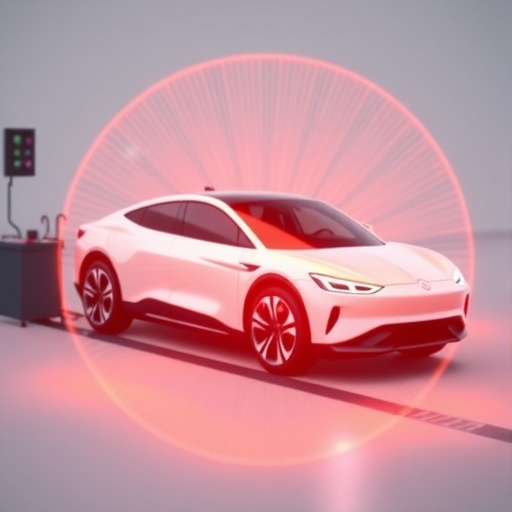In recent years, the quest for enhancing the longevity of vehicle batteries has taken center stage in the automotive industry. With electric vehicles (EVs) rapidly gaining market share and traditional combustion engine vehicles facing stricter regulations, the importance of knowing the state of health (SoH) of vehicle batteries has become critical. Research led by Wang, Hu, and Wu in their 2025 paper provides groundbreaking insights into accurately assessing the SoH of real-world vehicle batteries. Their innovative approach fuses frequency domain analysis with periodic signals, setting a new standard for battery assessment methodologies.
The health of a vehicle’s battery directly influences its performance, range, and overall reliability. As the demand for EVs continues to surge, manufacturers and consumers alike are eager for effective methods to gauge battery health. Existing techniques often rely on voltage and current measurements, often falling short in providing a comprehensive overview of a battery’s condition. The research by Wang and colleagues addresses this gap by employing a more nuanced dual-signal approach that integrates both frequency domain data and periodic signals, offering a more accurate representation of battery health.
Frequency domain analysis is a powerful tool that allows researchers to examine signals in terms of their constituent frequencies, providing insights that time-domain analyses sometimes obscure. In this research, the authors utilized sophisticated algorithms that take measurements of battery response across different frequencies. This allowed them to formulate a more vivid picture of the battery’s chemical and physical state, drawing on the characteristics of each frequency’s response to measure parameters like electrolyte conductivity and internal resistance.
In conjunction with frequency domain data, the fusion with periodic signals enhances the robustness of the health estimation. Periodic signals relate to the consistent electrical activities that occur within the battery during charge and discharge cycles. By examining these signals, the researchers can pinpoint abnormalities or decay patterns indicative of deeper issues, enabling a proactive approach to battery health management. This methodology represents a significant leap forward in predictive diagnostics for EV batteries.
Another critical finding of the study is the integration of machine learning techniques in interpreting the data extracted from the fused signals. The researchers trained algorithms on a variety of battery performance data, enabling the model to learn patterns associated with optimal and suboptimal battery health statuses. As a result, their approach is not only innovative but also scalable, providing a model that can be refined and used across different battery types and conditions.
The implications of this research extend beyond mere academic interest. With accurate SoH estimations, manufacturers could better tailor warranty services, while consumers could have access to reliable information about when their batteries need maintenance or replacement. This paradigm shift in how battery health is evaluated stands to revolutionize the relationship between electric vehicle owners and their batteries, fostering greater trust in battery technology.
The potential applications are vast, ranging from enhancing battery management systems in electric vehicles to improving energy storage solutions in renewable energy grids. The successful implementation of this dual-signal methodology could help mitigate the risks associated with unexpected battery failures, ultimately promoting a more sustainable and reliable energy landscape.
Moreover, as this research gains traction, it could catalyze further studies into adaptive battery management systems that incorporate real-time SoH analyses. Imagine a sophisticated onboard system that could continuously evaluate battery conditions and adjust charging or discharging protocols accordingly, maximizing performance while safeguarding battery life. Such advancements could be transformative for commercial transportation fleets, where operational efficiency and reliability are paramount.
Importantly, this research highlights the need for continual innovation in the field of battery technology. As consumer expectations evolve and environmental regulations become stricter, the pressure is mounting for automakers and energy providers to deliver increasingly sophisticated solutions for energy storage. The fusion of frequency domain analysis and periodic signals presents a promising avenue to address these challenges.
While the study outlines a clear path for future developments in battery health monitoring, it also opens the door for collaborative research efforts across disciplines. By bringing together expertise in electrical engineering, data science, and materials research, the industry has the opportunity to delve even deeper into the complexities of battery behavior under various conditions, pushing the boundaries of what is technically possible.
In conclusion, the advancements in battery health estimation presented by Wang, Hu, and Wu mark a significant step forward in ensuring that vehicle batteries are safe, efficient, and reliable. Their innovative approach intertwines frequency domain analysis with periodic signals, providing a comprehensive framework that enhances our understanding of battery health. As the automotive landscape continues to change with the rise of electric vehicles, this research underscores the importance of technological evolution in maintaining the integrity and performance of energy storage systems.
In an age where sustainability is not just important but essential, fine-tuning our approach to battery health is critical for a greener future. The work of these researchers exemplifies the innovative spirit needed to address the challenges posed by modern vehicle batteries. With continued research and development in this field, we can look forward to more resilient and efficient battery technologies, enabling a more sustainable transportation future.
Ultimately, as we embrace this new frontier in battery management, the information gleaned from this study will influence industry standards, consumer experiences, and even policy regulations related to energy storage in vehicles. The marriage of scientific research and practical application provides hope for a revolutionized automotive landscape driven by smarter energy solutions.
Subject of Research:
Estimation of the state of health of vehicle batteries using novel methodologies.
Article Title:
Estimation of the state of health of real-world vehicle batteries based on the fusion of frequency domain and periodic signals.
Article References:
Wang, J., Hu, S., Wu, M. et al. Estimation of the state of health of real-world vehicle batteries based on the fusion of frequency domain and periodic signals. Ionics (2025). https://doi.org/10.1007/s11581-025-06791-3.
Image Credits:
AI Generated
DOI:
https://doi.org/10.1007/s11581-025-06791-3
Keywords:
Battery health, electric vehicles, frequency domain analysis, periodic signals, machine learning, energy storage, predictive diagnostics, automotive technology.




